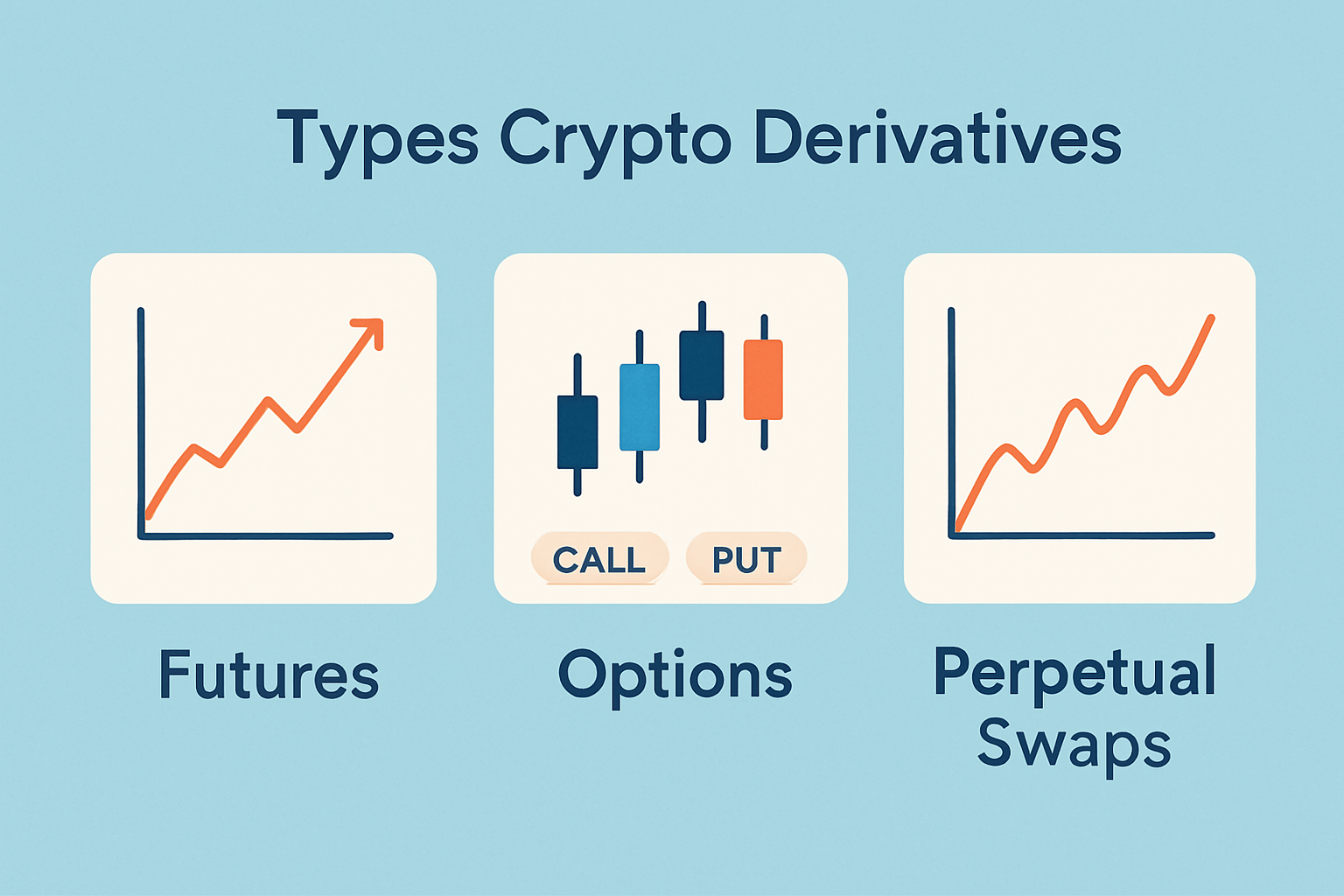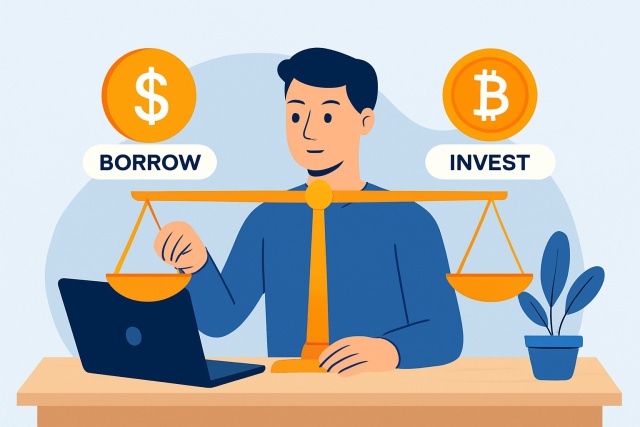Crypto Derivatives Explained With Simple Examples


Crypto derivatives explained: these are financial contracts that hinge on the price swings of cryptocurrencies like Bitcoin or Ethereum.
What Exactly Are Crypto Derivatives Anyway
Crypto derivatives are contracts tied to the ups and downs in the price of underlying cryptocurrencies. Instead of actually holding the coins in your digital wallet, traders snap up these agreements that allow them to ride the waves of price changes without ever owning the real asset itself.
Crypto derivatives are like futures contracts you see in commodities such as oil or wheat. Farmers and buyers lock in a price ahead of time so there are no surprises on delivery day. Stock options work similarly by giving investors the chance to buy or sell stocks at set prices in the future.
Different Types of Crypto Derivatives A Quick Dive Into the Buzz
- Futures are trusty instruments that let you lock in prices ahead of time
- Options offer you the flexibility to make a move without committing fully
- Perpetual swaps are contracts that never seem to expire and keep the action alive
- Contracts for difference (CFDs) let you speculate on price changes without owning the asset
- Leveraged tokens are high-energy players that amplify your exposure
Each flavor of crypto derivative has its own quirks and perks. Futures let you lock in a deal to buy or sell crypto at some point in the future. It is like making a plan that you hope sticks. Options are more flexible and give you the right but not the burden to go through with a trade. This can be a real lifesaver at times. Perpetual swaps behave like futures but without the looming expiration date. CFDs let traders bet on price swings without holding the crypto itself, which some find handy. Leveraged tokens crank up your exposure to price changes and make every move feel bigger.
What Makes Crypto Derivatives Truly Worth a Look
Crypto derivatives serve important purposes in trading and investing. Traders frequently use them as a shield against wild price swings that can make your head spin. Others use them to place bets on where the market might head. They also provide a way to increase leverage to boost potential returns, though with more risk. These instruments help investors diversify portfolios and play a big role in keeping the crypto market’s liquidity flowing smoothly.
- Managing price fluctuations to help shield your investments from nasty surprises
- Taking positions based on expected price changes to seize potential profit opportunities
- Applying leverage to amplify possible gains, while knowingly dancing with higher risks
- Spreading exposure without the hassle of owning the underlying assets outright
- Gaining access to assets that are usually tough to trade through clever derivative agreements
Crypto Derivatives Explained with Simple Examples That Actually Make Sense
Dive into how some common crypto derivatives actually work using straightforward examples that won’t make your head spin. These scenarios walk you through futures, options and perpetual swaps and show how savvy traders often lean on them to either dodge risk or chase profits.
You agree to lock in a Bitcoin futures contract at $30,000 payable in one month. If Bitcoin's price rises to $35,000, you gain $5,000 by settling at the lower contract price.
You grab a call option that gives you the right to buy Ethereum at $2,000 anytime within two months. If ETH shoots up to $2,500, you buy the coins at the cheaper rate and sell them at the market price.
You dive into Bitcoin perpetual swaps with 10x leverage, letting you turbocharge your daily trading moves without worrying about the contract expiration.
| Type of Derivative | Scenario Description | Potential Outcome | Risk Level | Use Case |
|---|---|---|---|---|
| Futures | Buy Bitcoin futures at $30,000, hoping the price will head north | Profit if BTC price climbs; having a locked-in price brings some peace of mind | Medium | Managing price swings or placing speculative bets |
| Options | Snag an Ethereum call option with a $2,000 strike price | Gives you the right to buy cheaper if ETH rises; worst case, you lose only the premium paid | Medium-High | Chasing speculative gains or hedging against risk |
| Perpetual Swaps | Dive into BTC perpetual swaps with 10x leverage for quick day trades | Bigger potential wins or losses thanks to leverage — proceed with caution | High | Jumping into short-term leveraged trades |

Risks and Things to Keep in Mind When Trading Crypto Derivatives A Few Nuggets to Remember
Trading crypto derivatives is no walk in the park mainly because the market's rollercoaster-level volatility and the leverage often in play can lead to substantial risks. It is all too easy to face big losses, including the dreaded liquidation if you slip up on your margin requirements. Beyond that, there are the sneaky risks hiding behind counterparties and the ever-shifting maze of regulations.
- Crypto markets are known for their wild ups and downs, often causing prices to swing in ways that can surprise even seasoned traders.
- Using leverage can increase your losses, sometimes wiping out more than what you originally invested. It is definitely not for the faint of heart.
- Be careful of liquidation risk because your position might get automatically closed if your margin drops sharply.
- Platform risk is real too since the exchange could face technical issues or get hacked, disrupting your trades.
- Regulatory uncertainty adds another layer of challenges with changing rules that may cause legal headaches and shake up the market.
When it comes to handling these risks, sticking to solid risk management practices is your best bet. Start with small trades and increase your exposure once you feel more at ease. Make it a habit to use stop-loss orders—they’re your safety net to keep losses in check. Also pick reliable and well-established platforms you can trust.
Exploring Crypto Derivatives in Decentralized Finance (DeFi) A Closer Look
Crypto derivatives rely on smart contracts running on blockchain platforms, making it possible to trade in a decentralized way—no middlemen breathing down your neck. You’ve got examples like synthetic assets that mimic real cryptocurrencies, and decentralized perpetual swaps that let you dive into trustless leveraged trading without breaking a sweat.
DeFi derivatives offer perks like open access and spot-on transparency but come with their fair share of bumps in the road. Think smart contract risks, thinner liquidity compared to centralized platforms, and a user experience that can sometimes feel like solving a puzzle.
A Beginner's Guide You Might Actually Enjoy
Diving into crypto derivatives trading starts with choosing a platform you can trust. Then you need to understand how margin and leverage work and finally put together a simple no-nonsense trading plan.
- Pick a well-regarded crypto derivatives platform known for solid security and positive user reviews you can trust.
- Get a good grasp on how margin and leverage work because this is your best bet for avoiding nasty surprises when risk sneaks up on you.
- Put together a straightforward trading plan with clear risk limits and goals. Nothing fancy, just something that keeps you grounded.
- Start off with a demo account or trade small amounts. Trust me, dipping your toes in before diving headfirst saves a lot of headaches.
- Keep a close watch on market trends and be ready to fine-tune your strategy because flexibility often makes the difference between winning and learning the hard way.
Common Misunderstandings About Crypto Derivatives Clearing Up the Confusion
Many individuals jump to the conclusion that crypto derivatives explained simply are only playgrounds for experts or that leverage is a fast track to easy money. There is also some skepticism with people thinking derivatives are sketchy scams or too risky to bother with and lack any real upside.
- Crypto derivatives might seem difficult for beginners at first. However, with patience and the right approach they become much easier to handle.
- Leverage is not a guaranteed way to lose. It is a double-edged sword that can increase both your wins and risks.
- Derivatives are not just for speculators. Many savvy investors use them as useful tools to manage and hedge risks.
- Derivatives are not shady scams. They are regulated financial instruments available on trustworthy platforms so you do not need to feel like you are taking a big risk.
- Here is an interesting point: you don’t always need to own cryptocurrency to get involved. Many derivatives allow you to participate without holding the coins.
Crypto derivatives can be pretty handy tools when you know how to wield them, but they’re not without their pitfalls if you’re not paying attention. Figuring out the right time and way to use them is key to unlocking their potential—while steering clear of any sticky situations.
Key Takeaways A Closer Look at Crypto Derivatives (Because There is More Than Meets the Eye)
Frequently Asked Questions
What’s the main difference between crypto futures and perpetual swaps?
Futures contracts have a fixed expiration date when the trade must settle. Perpetual swaps are like futures' more relaxed cousins because they never expire. This lets you hold onto them for as long as you want. They also use funding rates to keep their price aligned with the underlying asset, which likely makes them popular among those interested in longer-term leveraged trades.
Can I lose more money than I invest when trading crypto derivatives?
Yes, you definitely can especially with leveraged products like futures or CFDs. Leverage is a double-edged sword because it can increase your gains but also magnify losses quickly. If the market moves against you you might owe more than your initial margin. That is why I always recommend using risk management tools such as stop-loss orders and never trading with money you cannot afford to lose.
Are DeFi derivatives safer than centralized exchange derivatives?
Not necessarily. DeFi removes counterparty risk by relying on smart contracts instead of people but that comes with its own challenges. Bugs in the code or liquidity drying up are real risks. Centralized exchanges generally offer smoother liquidity and some user protections but you have to trust the platform itself. The bottom line is it is important to research both options carefully before getting started.
Do I need to own Bitcoin or Ethereum to trade crypto derivatives?
No, owning the actual coins is not required. Most derivatives let you speculate on crypto prices without holding the real assets. For example, CFDs or leveraged tokens derive their value from price changes alone so you only need collateral like stablecoins to begin trading. This makes derivatives accessible even if you do not have a large cryptocurrency stash.
How do I choose the right crypto derivatives platform?
Look for platforms with strong security measures such as cold storage for your funds and transparent fees. Positive user reviews are a good sign. Also check if they offer useful risk management tools like stop-loss orders and whether they are regulated because this adds extra peace of mind. If you are new consider platforms that provide educational resources or demo accounts where you can practice without pressure.
Is hedging with crypto derivatives worth it for small investors?
Absolutely, hedging can be a wise way to protect yourself from losses even if you are a small investor. For example, buying a put option on Bitcoin acts like insurance by limiting your losses if the price falls. That said, be mindful of the cost of premiums compared to possible benefits and consider starting small to see how this strategy fits your investment style.






